Tumor-infiltrating immune cells: triggers for tumor capsule disruption and tumor progression?
- PMID: 23532368
- PMCID: PMC3607233
- DOI: 10.7150/ijms.5798
Tumor-infiltrating immune cells: triggers for tumor capsule disruption and tumor progression?
Abstract
Background: Our previous studies of human breast and prostate cancer have shown that aberrant immune cell infiltration is associated with focal tumor capsule disruption and tumor cell budding that facilitate invasion and metastasis. Our current study attempted to determine whether aberrant immune cell infiltration would have similar impact on colorectal cancer (CRC).
Materials and methods: Tissue sections from 100 patients with primary CRC were assessed for the frequencies of focal basement membrane (BM) disruption, muscularis mucosa (MM) fragmentation, and tumor cell dissemination in epithelial structures adjacent and distal to infiltrating lymphoid aggregates using a panel of biomarkers and quantitative digital imaging.
Results: Our study revealed: (1) epithelial structures adjacent to lymphoid follicles or aggregates had a significantly higher (p<0.001) frequency of focally disrupted BM, dissociated epithelial cells in the stroma, disseminated epithelial cells within lymphatic ducts or blood vessels, and fragmented MM than their distal counterparts, (2) a majority of dissociated epithelial cells within the stroma or vascular structures were immediately subjacent to or physically associated with infiltrating immune cells, (3) the junctions of pre-invasive and invasive lesions were almost exclusively located at sites adjacent to lymphoid follicles or aggregates, (4) infiltrating immune cells were preferentially associated with epithelial capsules that show distinct degenerative alterations, and (5) infiltrating immune cells appeared to facilitate tumor stem cell proliferation, budding, and dissemination.
Conclusions: Aberrant immune cell infiltration may have the same destructive impact on the capsule of all epithelium-derived tumors. This, in turn, may selectively favor the proliferation of tumor stem or progenitor cells overlying these focal disruptions. These proliferating epithelial tumor cells subsequently disseminate from the focal disruption leading to tumor invasion and metastasis.
Keywords: Colorectal cancer; metastasis, lymphocyte aggregates.; tumor capsule; tumor invasion.
Conflict of interest statement
Competing Interests: The authors have declared that no competing interest exists.
Figures
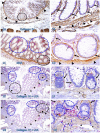
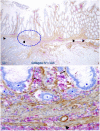
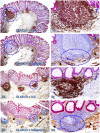
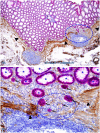
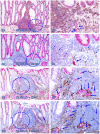
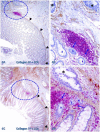
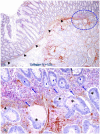
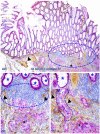
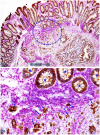
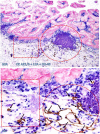
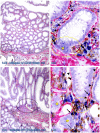
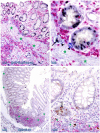

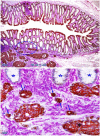
Similar articles
-
Cell budding from normal appearing epithelia: a predictor of colorectal cancer metastasis?Int J Biol Sci. 2013;9(1):119-33. doi: 10.7150/ijbs.5441. Epub 2013 Jan 11. Int J Biol Sci. 2013. PMID: 23355797 Free PMC article.
-
Differential impact of tumor-infiltrating immune cells on basal and luminal cells: implications for tumor invasion and metastasis.Anticancer Res. 2014 Nov;34(11):6363-80. Anticancer Res. 2014. PMID: 25368236
-
Focal degeneration of basal cells and the resultant auto-immunoreactions: a novel mechanism for prostate tumor progression and invasion.Med Hypotheses. 2008;70(2):387-408. doi: 10.1016/j.mehy.2007.05.015. Epub 2007 Jul 20. Med Hypotheses. 2008. PMID: 17658698
-
The significance of focal myoepithelial cell layer disruptions in human breast tumor invasion: a paradigm shift from the "protease-centered" hypothesis.Exp Cell Res. 2004 Dec 10;301(2):103-18. doi: 10.1016/j.yexcr.2004.08.037. Exp Cell Res. 2004. PMID: 15530847 Review.
-
[Mechanisms of metastasis and molecular markers of malignant tumor progression. I. Colorectal cancer].Postepy Hig Med Dosw (Online). 2006;60:453-70. Postepy Hig Med Dosw (Online). 2006. PMID: 17013365 Review. Polish.
Cited by
-
Tumor Budding Correlates With the Protumor Immune Microenvironment and Is an Independent Prognostic Factor for Recurrence of Stage I Lung Adenocarcinoma.Chest. 2015 Sep;148(3):711-721. doi: 10.1378/chest.14-3005. Chest. 2015. PMID: 25836013 Free PMC article.
-
Prostate cancer: from the pathophysiologic implications of some genetic risk factors to translation in personalized cancer treatments.Cancer Gene Ther. 2014 Jan;21(1):2-11. doi: 10.1038/cgt.2013.77. Epub 2014 Jan 10. Cancer Gene Ther. 2014. PMID: 24407349 Review.
-
Cutting edges and therapeutic opportunities on tumor-associated macrophages in lung cancer.Front Immunol. 2022 Nov 2;13:1007812. doi: 10.3389/fimmu.2022.1007812. eCollection 2022. Front Immunol. 2022. PMID: 36439090 Free PMC article.
-
Pan‑cancer analysis on the role of KMT2C expression in tumor progression and immunotherapy.Oncol Lett. 2024 Jul 19;28(3):444. doi: 10.3892/ol.2024.14577. eCollection 2024 Sep. Oncol Lett. 2024. PMID: 39091583 Free PMC article.
-
Integrated analysis identifies AQP9 correlates with immune infiltration and acts as a prognosticator in multiple cancers.Sci Rep. 2020 Nov 27;10(1):20795. doi: 10.1038/s41598-020-77657-z. Sci Rep. 2020. PMID: 33247170 Free PMC article.
References
-
- Topalian SL, Solomon D, Rosenberg SA. Tumor-specific cytolysis by lymphocytes infiltrating human melanomas. J Immunol. 1989;142(10):3714–25. - PubMed
-
- Baxevanis CN, Dedoussis GV. Papadopoulos NG, Missitzis I,Stathopoulos GP, Papamichail M. Tumor specific cytolysis by tumor infiltrating lymphocytes in breast cancer. Cancer. 1994;74:1275–82. - PubMed
Publication types
MeSH terms
Substances
Grants and funding
LinkOut - more resources
Full Text Sources
Other Literature Sources
Medical

